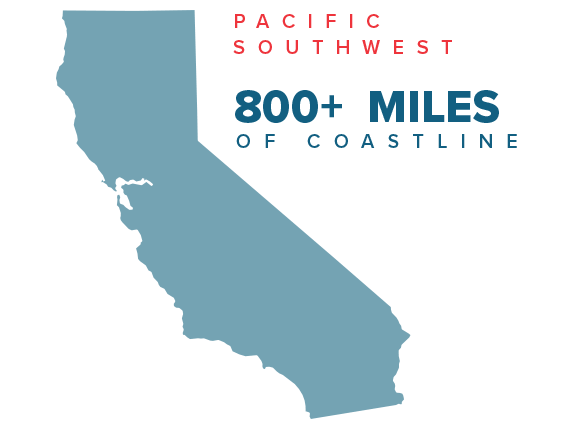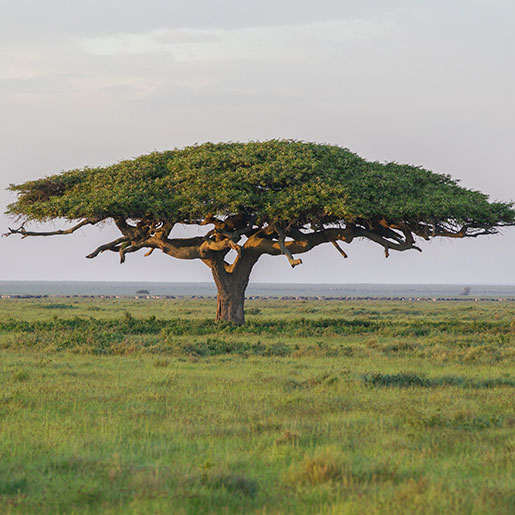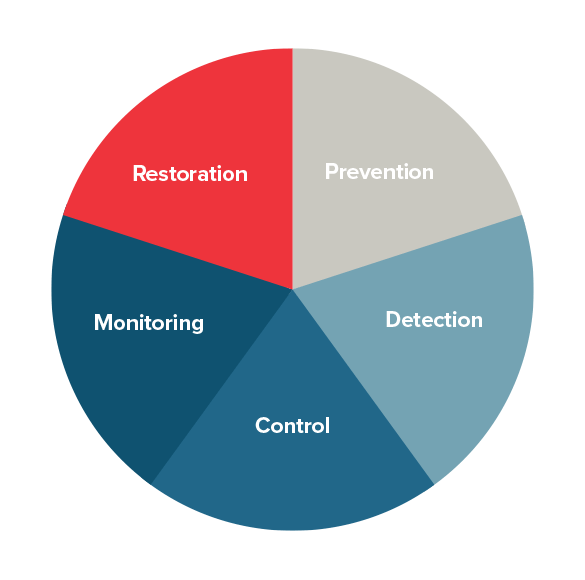Pacific Southwest Project Resources:

One hundred million acres in size, California is one of the most ecologically diverse states in the country. California has more than 3,400 miles of shoreline, 30,000 miles of rivers and streams, 4,800 lakes and reservoirs, 3 North American desert habitats, 3 forested mountain ecoregions, and coastal forests dominated by redwoods, the tallest trees in the world. California has more
native and endemic species than any other U.S. state, with over 750 native fish and wildlife species and over 6,000 native plants.
Development has led to enormous losses in wildlife and fish habitat. With a human population approaching 40 million, California’s natural lands face continual pressure from development. Since the 1900s, southern California has lost about 40,000 acres of wetlands to development.
Between 2001 and 2011, California lost 785 square miles of natural land to development, far more than any other western U.S. state. This loss of habitat threatens numerous species of plants and animals.


Source: thespruce.com
Removing invasive species and restoring native species brings myriad benefits. Restoration of wetlands, dunes, and other coastal areas protects against erosion, reduces flooding, and
improves water quality. Native birds, fish, and other wildlife return to restored areas, enhancing fisheries and biodiversity. Habitat improvement helps the recovery of threatened or
endangered species. Tourism and outdoor recreation benefit as people fish, bird watch, or visit wildlife areas.
Aquatic invasive species can harm local water supplies, damage native ecosystems, impact outdoor recreation activities, and threaten our health and safety. They cost the U.S. billions of dollars annually to manage and can cause long-term economic and environmental harm.
Common invasive plants in the California
Some of the most common invasive plants on the California coast are black acacia, umbrella thorn, giant reed, tree-of-heaven, iceplant, yellow starthistle, bull thistle, pampas grass, red and blue gum, edible fig, shamel ash, evergreen ash, Algerian and ‘California’ ivy, blue morning glory, ‘California’ privet, horehound, common iceplant, tree tobacco, fountain grass, castor bean, Himalayan blackberry, Brazilian pepper tree, salt cedar, tamarisk, common gorse, periwinkle, Mexican fan palm, and calla lily.
Invasive species and noxious weed classifications are very regionally specific. Sometimes, a plant classified as invasive in one area may not be invasive in another. Check the local noxious weed lists for species considered invasive and what level of control is required. Treatment/removal is unique to the plant species. Some species are easy to remove with hand pulling. Some species infestations are made worse by hand-pulling and must be controlled with pesticides in accordance with a permit. Consultation with local invasive species authorities is necessary when working with invasive species.


The best way for you to help prevent the spread of invasive plant species is to stop new outbreaks before they start. Each of us has a role in keeping our waterways clean and healthy for future generations. For example, the best way that you can help to prevent the spread of aquatic invasive species is to always clean your boat after use.
Early detection can help avoid many of the environmental and economic losses caused by invasive species. Reporting invasive species to the experts could stop the next invasion.
Report invasive species through the national Early Detection and Distribution Mapping System (EDDMapS).
Additionally, many states have invasive species reporting hotlines, online forms, or mobile apps. Using your internet browser, search with the terms “invasive species reporting [enter your state or county]” to discover how best to report in your area.

While invasive species pose major challenges, a number of management options exist. Prevention is important, but that is beyond the scope of this website. Physical or mechanical control, chemical control, cultural management, and biological control are all useful tools.
Removing invasive species and restoring native species brings myriad benefits. Restoration of wetlands, dunes, and other coastal areas protects against erosion, reduces flooding, and improves water quality. Native birds, fish, and other wildlife return to restored areas, enhancing fisheries and biodiversity. Habitat improvement helps the recovery of threatened or endangered species. Tourism and outdoor recreation benefit as people fish, bird watch, or visit wildlife areas.
What can you expect if you want to remove invasive species?
Invasive species removal can be a rewarding activity for any group of concerned citizens. Many species can be removed by hand, with little training. It is best to consult a local expert to understand the likely long-term outcomes of your effort. Some plant species can only be substantially reduced using fire, changing land elevation, or applying herbicides across large areas, in accordance with permits. One important role for local residents is participating in identification efforts to stop the spread of these species before they firmly take hold.

Prevention, detection, control, monitoring and restoration are all important objectives of invasive weed management programs. Source: https://www.fs.usda.gov
We need your help to improve the Toolkit by completing our easy, 3-minute survey. Your insight is valuable to us.